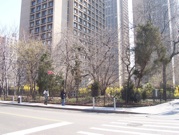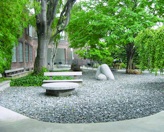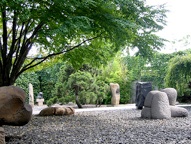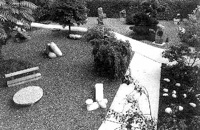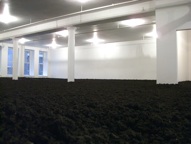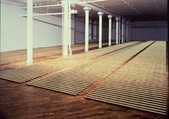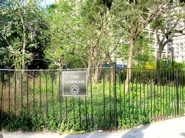arslocii
placeness as art


arslocii
placeness as art


















Quest for artistic endeavor in
NYC & LIC
This one-day adventure packed a lot of art into, simply, two locations – SoHo, in Manhattan, and Long Island City, Queens – two very different environments, although both densely urban. The former sites were all about context and the attempt to deal with concepts in the natural world, but placed into an unnatural context. The latter were mostly about reuse and betterment of industrial sites but in a very physical, not conceptual, way.
The New York Earth Room
SoHo, NYC
To see this Walter De Maria piece, we enter yet another oddball Dia location, this time on Wooster Street in an old cast-iron-facaded factory building with a plain steel door and a bell marked simply, “DIA.” Once inside, there is an average lobby with elevators where a sign points you to a small enclosed side stairway. At the first or second step, the smell hits you: a moist, dank, sweet, unfamiliar scent that you never experience in the hard-surfaced concrete streetscape you just left. Maybe never in all of Manhattan. As you ascend the stairs the fragrance and the dew point continue to rise to a heady level. Straight ahead is an information desk, but where is the gallery? Pivoting to the right, you see a thick panel of glass, maybe 3’ high, spanning a door jamb with a dark substance pressing against it about two feet deep. There is an unearthly (although, actually, precisely the opposite) color emanating from the otherwise white-walled space, windows cutting across both ends of the expansive 3600 sq. ft. room; what you suddenly realize is, that room is filled to a level height with literally tons of amazingly rich dirt the color of coffee grounds. Totally distorting reality, this earth-filled room confuses the idea of interior and exterior, art and gallery, natural and unnatural. The subtle beauty is exquisite, the deep burnt umber of the soil being played on by daylight as well as the gallery lighting. There is only one vantage point – from the narrow doorway, leaning slightly over the glass panel to enable more encompassing views. On the opposite side of the filled room is a partition leading to another small room, but you can’t see into it, you can only see that it looks as though the earth continues on into it as well, on into infinity. The whole thing is seductive and sensual, but bizarre, nonsensical, surreal. Oddly, emotional. And just plain lovely. It plays with your mind and your senses, draws you into its ordinariness and extraordinariness. If you let it happen to you, its memory will be familiar and indelible.
The Broken Kilometer
SoHo, NYC
Just a few blocks from the previous site is another work by De Maria. This one has a bit more of a gallery presentation although there is no visible sign from the street as to what is within the mysterious facade. The large glass windows are covered and you enter into a corridor that leads around a partition, then, boom! – huge space with cast-iron columns in a row to one side, and on the refinished pine floor lay 500 polished brass rods, all of equal length, perfectly lined up like the Terracotta Army in Xi’an. Only this installation is about measurement rather than might. Here you go again, Walter, playing with our heads. Again, making the material seductive but this time in a hard-edged, shiny, glowing sort of way, enhanced by the stadium lighting, untouched by natural light. Not only does the texture draw you in but also the repetitiveness, and the created perspective (move over Alberti) is confounding in this space. Also, as with the Earth Room, this piece slows you down, brings you into its space and time. These rods, if placed end to end, would form a column a kilometer long, and you gaze at them trying to imagine that. And, of course, you get the concept that here is a literal kilometer, compressed into this 45’ x 125’ room. Again, it’s about context, and also about bullying you into an attempt to wrap your mind around spatial concepts and scale. This is a big freakin’ interior space and yet it is puny compared to outdoor space and distance. It is a material manifestation of a conceptual, manmade length of land and measurement. Inside vs. outside again. This work is more intellectual than sensual, although it does have that glow; perhaps more science than art. Thankfully, given the mind-boggling nature of making a concept real, it wasn’t called “The Light Year.”
Time Landscape
Greenwich Village, NYC
This installation by Alan Sonfist is another conceptual and contextual piece, and it is pretty hard to locate despite where and what it is: a swath of green surrounded by concrete. This small, 25’x 40’ plot of ground is dwarfed by everything around it, as it is supposed to replicate, though in microcosm, a pre-colonial forest. It mostly resembles the kind of untended, weedy median strip you’d find on most American highways. The difference is, this is fenced all around and has an explanatory sign at its origin point. We circumnavigated it, peering through the semi-thicket, maybe looking for something to latch onto. It has the unpleasant feel of a too-small cage at the zoo for some poor hapless creature whose habitat is to roam. Unnoticeable in this entirely over-built context? Well, yes. As to the point of it – to show a slice of what the original Dutch settlers might have found on the entire island of Manhattan when they landed – it is a regenerated ecosystem of native trees, shrubs and ground covers. The concept is right-on but doesn’t work visually without the essay of explanation. This less than a tenth of a city block is, dare we say, almost too insignificant to have much of an effect. In addition, there is a sidewalk all around it. On the east side of the caged strip a walkway divides this native wild and wooly display from a green, landscaped area belonging to a towering building complex. With its nearly identical fence and mixed border plantings of trees and shrubs, it feels not dissimilar to the native plantings across the way, only it looks better. There’s your context. The questions we had were: What was in proximity to “Time Landscape” when it was first designed and planted, and did that context set it apart more, emphasize it more, make more of a statement? When the initial proposal for the installation was made in 1965, the adjacent Brutalist-style University Towers were not yet built, but the towers ended up being in place ten years before “Time Landscape” was realized. Now that there is cultivated green space around it, does it still have the same meaning or impact? Time does alter things, meaning and intention as much as context, and certainly the point of this piece when it was created.
The Noguchi Museum
Long Island City, Queens
Getting to this locale is not a simple task. The subway into Queens stops, at its closest point, two miles or more from its front door (which was actually a temporary side door). It is an interesting walk through mixed ethnic neighborhoods of residential, commercial and light industrial, in that order, as you make your way west toward the East River. It is obvious, as you approach land’s end, that this was once a heavily industrial zone, due east of Manhattan. The Noguchi Museum is somewhat isolated, a former factory building that is immediately recognizable by its design intelligence. It gets even better inside. Cool industrial styling makes for a nice backdrop for the sculptor’s massive and simple forms. Not only are the works of a larger scale than expected, there are so many of them, and this huge space can handle them easily. It’s almost as if this prolific artist made a sculpture each day of his life. One of the real goals was to see his sculpture garden, imagining the combination of his shapes relating to an Asian garden design and the symbiosis they form – we were hopeful for a special treat of arslocii. Alas, the garden was closed for renovation. Not a happy disclosure since this was the main point of our visit. Nevertheless, the museum is full of seriousness and fun, has a nice gift shop where you can relax with tea, and has hours worth of sculpture to view. All this means is that we will have to return to complete our mission.




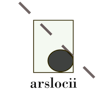
arslocii, a creation of Probasco Haus Press
copyright © 2010 Probasco Haus Press LLC
Top Left: Signage at Time Landscape, NYC.
Bottom: The Broken Kilometer by Walter De Maria, NYC.
Right: The Noguchi Museum, LIC, NYC.
